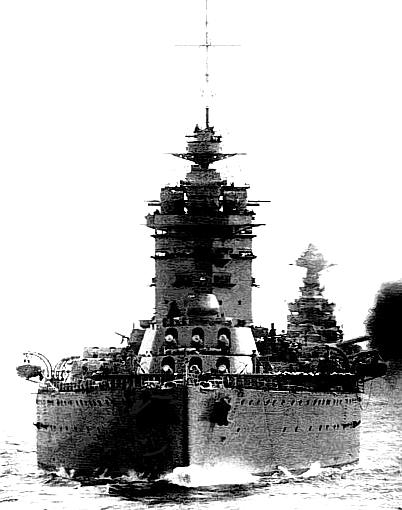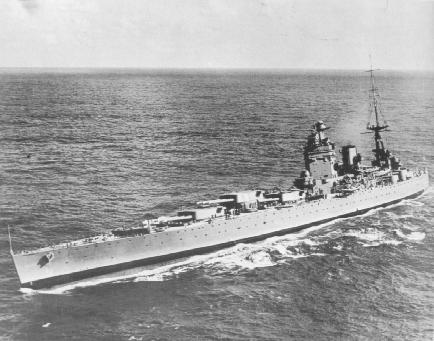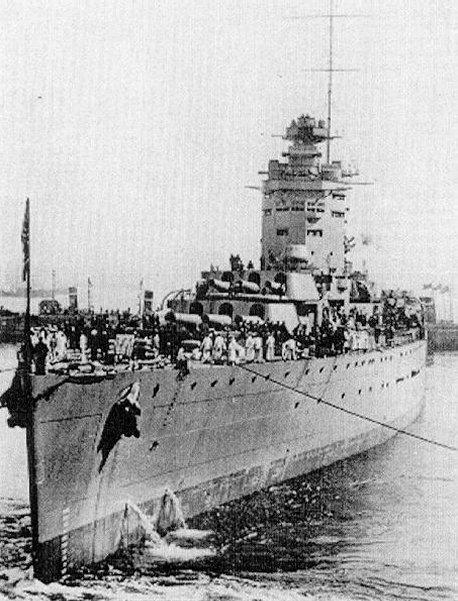HMS Rodney

At the beginning of the war RODNEY was at Scapa with the Home Fleet. Her first action with the enemy was on 26th September when the RODNEY, NELSON and ARK ROYAL were covering the crusiers AURORA and SHEFFIELD escorting home the damaged submarine SPEARFISH. The Force was attacked by aircraft about 2:30pm some 150 miles from the Norwegian coast, but no damage was inflicted though the Germans claimed the ARK ROYAL had been sunk. During October and November RODNEY put to sea several times for patrol and excerises, and then docked at Liverpool for rudder repairs from 9th to 29th December. The flag of C. in C., Home Fleet, was transferred to RODNEY on 1st January, 1940, and on 7th March RODNEY, with the First Lord, Mr. Churchill, on board, left the Clyde for Scapa.
 On the evening 8th April reports came in of enemy movements to occupy Norwegian ports, so the Home Fleet put to sea from Scapa. At noon on 9th April the main fleet (RODNEY, VALLIANT, 6 crusiers and 8 destroyers) was off Bergen, and for over three hours in the afternoon were attacked by enemy aircraft. The RODNEY was hit by a 1,000lb bomb which fortunately broke up on the armoured deck and did not penetrate. The Fleet returned to Scapa on 17th April. RODNEY and RENOWN and their destroyer screen, sailed from Scapa on 9th June to cover a troop convoy returning from Norway. The following morning, on receiving a report that the GNEISENAU and HIPPER had put to sea from Trondheim, the C. in C. altered course towards them and ordered the ARK ROYAL to join him. An extensive reconnaisance by aircraft failed to find the enemy, and at midnight the Fleet turned back to provide cover to the convoys from Narvik. In the meantime, the two German ships had rejoined the SCHARNHORST at Trondheim and it was decided that naval aircraft should attack them. The Fleet was then, 11th June, somewhere to the northward and turned south that evening. At 2am on the 13th the aircraft left the ARK ROYAL to carry out the attack, and on their return reported that the SCHARNHORST had been hit by at least one bomb. The fleet went back to Scapa, the RODNEY and RENOWN entering the harbour on the 15th.
On the evening 8th April reports came in of enemy movements to occupy Norwegian ports, so the Home Fleet put to sea from Scapa. At noon on 9th April the main fleet (RODNEY, VALLIANT, 6 crusiers and 8 destroyers) was off Bergen, and for over three hours in the afternoon were attacked by enemy aircraft. The RODNEY was hit by a 1,000lb bomb which fortunately broke up on the armoured deck and did not penetrate. The Fleet returned to Scapa on 17th April. RODNEY and RENOWN and their destroyer screen, sailed from Scapa on 9th June to cover a troop convoy returning from Norway. The following morning, on receiving a report that the GNEISENAU and HIPPER had put to sea from Trondheim, the C. in C. altered course towards them and ordered the ARK ROYAL to join him. An extensive reconnaisance by aircraft failed to find the enemy, and at midnight the Fleet turned back to provide cover to the convoys from Narvik. In the meantime, the two German ships had rejoined the SCHARNHORST at Trondheim and it was decided that naval aircraft should attack them. The Fleet was then, 11th June, somewhere to the northward and turned south that evening. At 2am on the 13th the aircraft left the ARK ROYAL to carry out the attack, and on their return reported that the SCHARNHORST had been hit by at least one bomb. The fleet went back to Scapa, the RODNEY and RENOWN entering the harbour on the 15th.
The flag of the C. in C., Home Fleet, was transferred to the NELSON on 24th July, and RODNEY sailed to Rosyth on 23rd August for the retubing of her boilers. The battleship left Rosyth on 4th November and was ordered to give covering protection to Halifax convoys. The ship joined the convoy on the morning of 12th November and left on the afternoon of the 20th. On 5th December RODNEY proceeded once more from Scapa towards Halifax to rendezvous with an important convoy which had left there on the 3rd. The voyage home was uneventful, but RODNEY sustained heavy weather damage and sailed to Rosyth for necessary repairs, arriving at the port on the 17th. The battleship left Rosyth on 13 January, 1941 and proceeded to Scapa. RODNEY then provided escort to a homeward bound Halifax convoy from 12th to 23rd February. No enemy interference was encountered.
 On 9th March RODNEY sailed from Scapa with other ships for the Home Fleet, but was detached on the 13th to rendezvous a convoy on passage from Halifax, During the evening of 16th March a raider distress message was received from the M/V CHILEAN REEFER. RODNEY proceeded at full speed towards the position and sighted her on fire some distance ahead. Then, almost immediately, sighted a warship with a large tanker in company at a distance of 15 miles. The RODNEY gave chase but the ships disappeared in the darkness. By this time it was quite dark, and RODNEY made search for possible survivors in the vicinity of the burning vessel. A boat containing 27 men, including the Captain and Chieg Officer of the CHILEAN REEFER was sighted and the survivors taken on board. They stated that the enemy ship was the GNEISENAU. Further search revealed no trace of any other survivors, and RODNEY turned to rejoin the convoy. On 24th March, an unknown vessel was sighted and asked to identify herself. No reply was received and she was ordered to stop. She still continued her way so warning shots were fired across her bows. The vessel then signalled she was the VILLE DE LIEGE and was allowed to proceed on her passage. The convoy arrived at the United Kingdom without any further incidents. RODNEY then proceeded to Halifax and left there on 10th April as senior escort ship to a Canadian troop convoy which arrived in the Clyde on the 19th without mishap.
On 9th March RODNEY sailed from Scapa with other ships for the Home Fleet, but was detached on the 13th to rendezvous a convoy on passage from Halifax, During the evening of 16th March a raider distress message was received from the M/V CHILEAN REEFER. RODNEY proceeded at full speed towards the position and sighted her on fire some distance ahead. Then, almost immediately, sighted a warship with a large tanker in company at a distance of 15 miles. The RODNEY gave chase but the ships disappeared in the darkness. By this time it was quite dark, and RODNEY made search for possible survivors in the vicinity of the burning vessel. A boat containing 27 men, including the Captain and Chieg Officer of the CHILEAN REEFER was sighted and the survivors taken on board. They stated that the enemy ship was the GNEISENAU. Further search revealed no trace of any other survivors, and RODNEY turned to rejoin the convoy. On 24th March, an unknown vessel was sighted and asked to identify herself. No reply was received and she was ordered to stop. She still continued her way so warning shots were fired across her bows. The vessel then signalled she was the VILLE DE LIEGE and was allowed to proceed on her passage. The convoy arrived at the United Kingdom without any further incidents. RODNEY then proceeded to Halifax and left there on 10th April as senior escort ship to a Canadian troop convoy which arrived in the Clyde on the 19th without mishap.
On 22nd May, news reached the C. and C., Home Fleet, that the BISMARCK and PRINZ EUGEN were at sea. The RODNEY, with four destroyers, was escorting the troopship to BRITANNIC to Canada. She was ordered to leave the BRITANNIC, and did so at noon, leaving one destroyer and proceeding with the other three. By daybreak on the 27th May the C. in C. in KING GEORGE V, who had been joined by RODNEY the previous day, had worked round the position of the BISMARCK to attack from the westward. At 8:43am the BISMARCK was sighted at about 25,000 yards range. The RODNEY opened fire at 8:47am, followed one minute later by KING GEORGE V, and then by BISMARCK, who directed her fire at RODNEY. At 9am the range was 20,000 yard and rapidly decreasing. By 9:30 BISMARCK was on fire and virtually out of control. RODNEY, KING GEORGE V, and the cruiser NORFOLK - who had now joined in the action - continued firing at ranges which eventually came down to 3,300 yards. By 10am BISMARCK's main armament was out of action, though her secondary armament was still firing spasmodically. By 10:10am this too had ceased, and BISMARCK was now a wreck pouring high into the air a great cloud of smoke and flames. The cruiser DORSETSHIRE - which had now arrived on the scene - torpoedoed BISMARCK on both sides and she sank at 10:37am with her colours still flying. KING GEORGE V and RODNEY, while on their way home, were attacked by two enemy aircraft. Both aircraft were driven off and jettisoned there bombs in the sea; one of the aircraft was hit by RODNEY and was last seen losing height as it disappeared four miles astern.
RODNEY left the Clyde for Halifax, arriving on 10th June, and then proceeded to Boston to undergo a refit. This completed on 12th August, and RODNEY sailed to Bermuda. The battleship was then ordered to the Mediterranean to join Force 'H' and arrived at Gibraltar on 24th September. On the 27th a report was received of a strong Italian naval force speeding at 20 knots for a convoy which Force 'H' was escorting through the western end of the Mediterranean. The PRINCE OF WALES, RODNEY, cruisers and destroyers were detached to close the Italians. By 2:25pm the total enemy forces sighted were 2 battleships, 4 cruisers and 16 destroyers, but very soon this enemy force turned and ran for the shelter of Naples. As the enemy could not be reached before dark, our ships were withdrawn. On 16th October, Force 'H', with RODNEY as Flagship, sailed from Gibraltar to provide support to ARK ROYAL on an aircraft ferrying operation to Malta. On the afternoon of the 17th the aeroplanes were flown off and the Force returned to Gibraltar. On the 30th RODNEY was ordered home, and left Gibraltar on 2nd November, arriving at Aultbea on the 8th. She left the same day for Iceland to be stationed at Hvalfiord to be handy if raiders threatened the convoys.
 On 16th February, 1942, RODNEY arrived at Liverpool for refit and completed 5th May. She left Scapa on 3rd June to escort a convoy to Freetown and returned on 26th July. The battleship left again on 2nd August for convoy duty in the South Atlantic, but was detached to form part of a force escorting an important convoy to Malta. (Operation PEDESTAL). RODNEY joined the convoy on 10th August and passed through the Straits of Gibraltar that same day. On the 11th, 12th and 13th the convoy was continously attacked throughout the days and nights by dive bombers, torpedo carrying aircraft, submarines, and even E-boats, and losses were heavy on both sides. RODNEY took her full share in repelling the attacks and, so far as could be seen in the general situation, had quite a number of successes against enemy aircraft, though she, herself, was damaged by a near miss.
On 16th February, 1942, RODNEY arrived at Liverpool for refit and completed 5th May. She left Scapa on 3rd June to escort a convoy to Freetown and returned on 26th July. The battleship left again on 2nd August for convoy duty in the South Atlantic, but was detached to form part of a force escorting an important convoy to Malta. (Operation PEDESTAL). RODNEY joined the convoy on 10th August and passed through the Straits of Gibraltar that same day. On the 11th, 12th and 13th the convoy was continously attacked throughout the days and nights by dive bombers, torpedo carrying aircraft, submarines, and even E-boats, and losses were heavy on both sides. RODNEY took her full share in repelling the attacks and, so far as could be seen in the general situation, had quite a number of successes against enemy aircraft, though she, herself, was damaged by a near miss.
RODNEY arrived at Gibraltar on the 14th and then proceeded to Scapa. On 22nd August the ship arrived at Rosyth for docking and completed 15 September. RODNEY left the United Kingdom at the end of October on escort duty to a convoy bound for North Africa. In the North African assaults (Operation TORCH) RODNEY was in support at Oran to protect the anchorage from attacks by heavy enemy forces. The battleship also bombarded shore postions, and her special objective was the silencing and destruction of Fort Santon. On the 8th, 9th and 10th November, this strong and well placed fort was bombarded by the RODNEY until it eventually capitulated on the 10th. RODNEY, as part of Force 'H', continued to cover operations on the North African coast until her return to Gibraltar on 22nd November. From then, until May, 1943, RODNEY was engaged with Force 'H' in the duties of covering the operations which followed the initial phase of the landings. An attempted attack by two human torpedos was made on Force 'H' at Mers-elKebir, Oran, on the night of 23rd March. They were fired on by patrols on the breakwater and by FORMIDABLE berthed alongside. They disappeared and no attack developed.
On 7th May, 1943, RODNEY left Gibraltar for Plymouth, where she was docked for repairs on the 13th and completed 28th. The battleship then rejoined Force 'H' at Gibraltar, arriving on 23rd June. RODNEY, as a unit of Force 'H', took part in the invasion of Sicily (Operation HUSKY) on the 10th July. On 6th July RODNEY sailed for Algiers with the 1st Division of Force 'H' to rendezous south east of Malta in readiness for D-day. Their part in the assault was to cover the landing forces from interference by enemy surface forces, and to carry out bombardments by the battleship if need be. During the first two days Force 'H' cruised in the vicinity of its covering position, and was not called upon for bombardments. RODNEY with the 1st Division, proceeded to Malta on 12th July, where she anchored off the breakwater. (This was the first visit of British battleships to Malta since December, 1940). Force 'H' continued to cruise in the vicinity of the operations and, while several attacks by aircraft and submarines took place on units of the Force, RODNEY was not called upon for action.
On the morning of 31st August, the battleships NELSON and RODNEY and cruiser ORION with destroyer escorts, made a sally into the Straits of Messina and carried out bombardments of the Calabrian coast. The targets were coast defence batteries north east of Reggio, and spotting aircraft reported that these targets were well covered by battleships' bombardments. On 7th September, RODNEY sailed from Malta to provide cover for the assault convoys for the Salerno landing on 9th. On the 8th, when Force 'H' was about 60 miles south west of Capri, attacks were made by enemy torpedo carrying aircraft. None of our ships received damage, though WARSPITE and FORMIDABLE were narrowly missed. The A/A fire of the Force was effective: at least three of the enemy aircraft were seen to crash and three more thought to have been destroyed. On the 9th and 10th, Force 'H', including RODNEY, maintained a patrol of the seas off the West Coast of Italy, but on the evening of the 11th withdrew to Malta. With the surrender of the Italian Fleet, one of the reasons for the existence of Force 'H' ceased and the title lapsed on 18th October, 1943.
RODNEY arrived in the Clyde on 5th November to undergo repairs, and left on 16th December for Scapa. On 28th February, 1944, the ship went into dock at Rosyth and completed repairs on 28th March. RODNEY then took part in the Invasion of France as a unit of the bombarding forces. By the 9th of June the warships were intervening in the fighting on shore, and RODNEY assisted the 3rd British Division to hold an enemy counter-attack. Continuing her support of the Army, RODNEY, on 30th June, bombarded two important enemy concentrations, and on 7th July shelled the Houlgate area, at the mouth of the Dives. On the 8th the ship engaged important targets with great success in support of the Caen offensive, As the fighting on land receeded, there was naturally fewer opportunities for shore bombardments by H.M. Ships, and RODNEY withdrew from the area.
On 12th August, RODNEY bombarded heavy enemy gun batteries on Alderney, Channel Islands, and three of the four guns in the battery were reported damaged. The RODNEY returned to Portland and later proceeded to Scapa, arriving on 14th September. On the 16th the battleship left Scapa to give covering protection to Russian outward and homeward bound convoys, and returned to Scapa on 4th October. On 30th November the flag of C. in C., Home Fleet, was transferred to RODNEY, and the ship remained at Scapa Flow until April, 1945, when she was relieved by RENOWN.
After the end of the War in 1945 the RODNEY was laid up at Rosyth. Approval to scrap her was given in January, 1948, and later that year she was taken in hand for breaking up by Messrs. T.W. Ward at Inverkeithing.